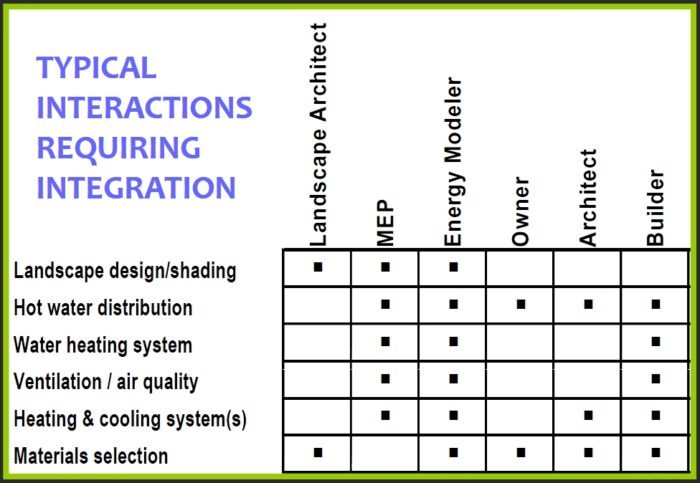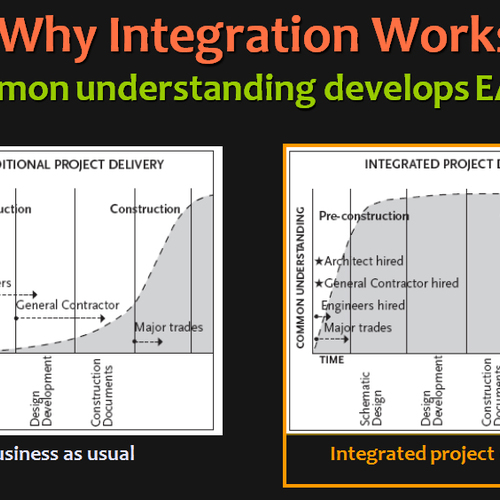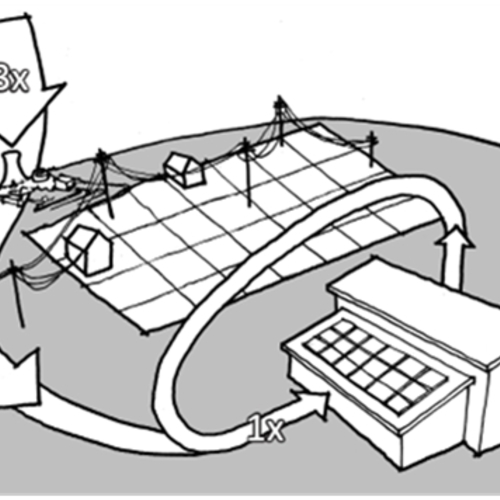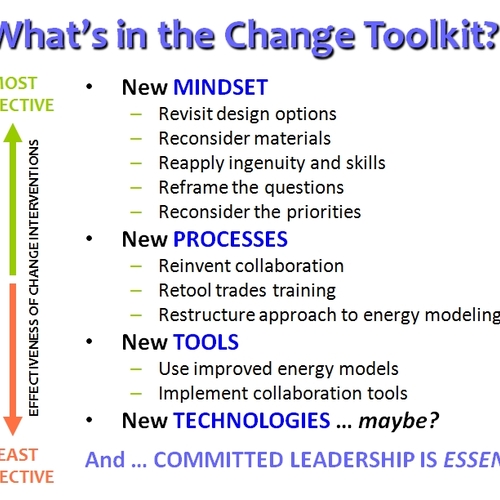
Image Credit: Sprial stairs photo: © Dashark | Dreamstime.com
In the prior installment in this blog series, I proposed a rationale for the adoption of integrated project delivery (IPD) and promised to follow with suggestions regarding its implementation, along with some resources.
Meanwhile, that last blog generated a great dialogue (and a few diatribes – always a plus!) about that classic IPD bugaboo, the design-bid-build model. Many of the commenters echoed my own very strong sentiments in favor of involving contractors during early design stages, and gave some great suggestions for how to do that. I won’t reiterate those here, but do encourage anyone who hasn’t read them to do so.
The Siamese twins of IPD
Before moving on to the discussion of IPD implementation, I’ll share a couple of fundamental principles I’ve derived from my own experience – realizations resulting from shortcomings in process (failures have a way of providing teachable moments, don’t they?!) that have strongly shaped my views about implementation.
Principle #1: Sound Process. If your process is sound, good outcomes will follow. In other words, it’s kind of tough to produce a lousy project if you’re observing a well-crafted (integrated) process.
Principle #2: Right Players. A sound process, carried out by the right people, all but guarantees a good project (or product). The “right people” are qualified, committed, and creative. By qualified, I mean having prior relevant experience – ideally on other high-performance projects, and projects that are comparable in nature (building type) and scope (size, complexity). Committed players are also crucial, and in fact, a team member who lacks an ideal background but who is hugely enthusiastic about the undertaking can be a great asset. And finally, a spirit of creativity and innovation are essential. Ultimately, attitude trumps experience, if you can’t have both.
These two principles are Siamese twins; one can’t exist without the other.
IPD means following some rules
My principles, above, were the result of observations about things that were working well, and some things that weren’t. Further observation and reflection on those principles over many years has led me to a set of basic rules for implementing IPD:
Rule #1: Committed Leadership. Committed leadership is absolutely crucial. If either the purse-strings are controlled by a party who is not committed to IPD or the project team leader is not committed to IPD, it simply can’t happen. A sound process won’t be observed, and you may be unable to engage the right players.
Rule #2: Designate a Champion. It’s critical to have an IPD champion within the project team. IPD is not the normal way building projects are developed; hence, someone needs to be responsible for its care and feeding. This may be anyone on the team, but ideally a seasoned professional with prior IPD experience or someone who is enthusiastic about the prospect of fulfilling this role and who is very organized.
Rule #3: Be Inclusive. As much as you can, include every team member in your IPD process from the earliest possible date (or, by definition, it’s not so integrated). There’s a very practical reason for this: the person left out is the one who will cause problems – not out of malice, stupidity, or laziness, but typically because of a lack of understanding of the project’s goals or of the reasoning that underlies particular decisions. (Hearken back to part 4 in this blog series.)
Rule #4: Establish Communication Protocols Early. As a team, identify the range of systems, materials, and issues that will need to be addressed as the project progresses, and the team members who should be involved in communications about each of these areas. Often it’s a pretty comprehensive matrix; the sample shown below arguably is missing some dots.
Rule #5: Use an Online Workspace. There are a number of online workspace options, ranging in sophistication from the fairly rudimentary (e.g., Buzzsaw, Google Docs) to the more fully-featured such as Central Desktop and Basecamp, which I use because it offers a reasonably good balance between functionality and price. The two principal values of these utilities are:
• Version control – everyone should have access at all times to the most current version of all project documents;
• Email conversation archive – dialogue among team members about particular issues should be easily accessible from one central point without having to mine individuals’ sent or received email boxes.
Several other types of resources can support IPD
Contracts. In many discussions of IPD, the issues of responsibility and liability come up. Understandably, this is of paramount concern when project teams deviate from the standard approach to project delivery. A number of relatively new contract forms have evolved to address this need, including the following:
- AIA A195/B195/A295 Standard Form of Agreement Between Owner and Contractor/ Owner and Architect for Integrated Project Delivery
- AIA C195 Standard Form Single Purpose Entity Agreement for Integrated Project Delivery
- Consensus DOCS 300 Standard Form of Tri-Party Agreement for Collaborative Project Delivery
Meeting Resources. As prosaic as it sounds, meeting logistics can be one of the biggest challenges an IPD team faces. There are a number of free online scheduling utilities; I find Doodle to be particularly user-friendly. When an in-person meeting isn’t possible, a conference call (e.g., FreeConference) or web-based meeting is often a good compromise. Skype provides not just free and low-cost calling, but also has a remote desktop sharing feature which is very easy to use. There are numerous web-based meeting services; among the more popular are Webex, GoToMeeting, and Adobe Connect.
Information Resources. While not explicitly targeted to IPD teams, these resources can help teams more quickly arrive at sound decisions on high-performance projects:
- Building America 50% savings packages (climate-specific packages of energy features that will yield 50% energy savings compared with code-built homes)
- Building Green product reviews, case studies, and in-depth articles
- Green Building Advisor case studies on net-zero and other highly energy-efficient residential projects (and much more, of course!)
- National Renewable Energy Laboratory information on solar thermal and solar electric systems, among many other resources
- Florida Solar Energy Center research, case studies, and much more
Collaboration Utilities. There is a diverse and rapidly increasing variety of online utilities that can help support good teamwork. One type is mind-mapping software such as Mindjet, which allows users to create online bubble diagrams and attach myriad types of information to them, including documents of all types, images, emails, urls, etc. This is a very dynamic tool for visually organizing information and ideas, and all team members can contribute. Houzz and Pinterest are representatives of another emerging class of utilities that are designed to allow users to create and share collections of visual information.
Closing thought: integrated ≠linear
In Part 4 I described the conventional or predominantly linear handoff process by which buildings are designed and constructed. Integrated project delivery, by contrast, is iterative rather than linear. And while a certain amount of iteration is inevitable even in a normal process, it’s a defining feature of IPD. For those new to IPD, this may seem inefficient, evoking sensations of déjà vu – didn’t we already discuss this? Didn’t we already decide? However, the nature of IPD is such that deeper discussion and more intensive collaboration reveals more nuance and therefore a more thoughtful and carefully considered approach to design and construction. Hence revisiting some ideas and decisions is inescapable.
I like the metaphor of the spiral staircase to represent this phenomenon – although the landscape may be strikingly familiar as you move from one stage of a project to the next, in fact you are progressing towards your goal. And paradoxical as it may seem, this spiraling process is the quickest route from the start of design to your destination – a highly efficient and resourceful building. Many of my colleagues who have been involved in designing high-performance projects attest to this, perhaps none so succinctly as Scott Shell of EHDD Architects in San Francisco:
“Integrated design can reduce construction cost while providing significant sustainable design benefits. On the CSU [California State University] Monterey Bay Library, by comparing a number of integrated structural, mechanical, and architectural schemes, we found that tradeoffs from one discipline more than offset added costs in another, while achieving energy savings of almost 40 percent.”
Weekly Newsletter
Get building science and energy efficiency advice, plus special offers, in your inbox.
















10 Comments
Rule by committee... time to
Rule by committee... time to study Robert's Rules of order...
or...
Design/build, done- one big texas style hat... meetings wherever one is... done. next decision, come on down....
IPD
IPD is a last gasp to maintain control w/o responsibility for the AIA. Go with D/B and those carrying the freight.
Re: design/build
Disappointing responses from AJ and RR. If D/B is your thing, go for it. If it isn't, Ann gives some great pointers here on how to better integrate the skills and insights of the whole team toward achieving a superlative product.
Design/build has a lot to offer but it's not the magic bullet. I've seen great d/b projects and some ghastly ones. With all due respect there's great unevenness under that 'big Texas hat' and I'm sorry to say that too often in these recessionary times design/build is just a contractor with a fifty-dollar CAD program and too much time on their hands.
"Integrated design can reduce
"Integrated design can reduce construction cost" Ann... are we talking about building a home or a university? I can see your process and your blog series being helpful for multimillion dollar overfunded public projects... but... for a simple house this is nuts talk. Many home builders like myself design/build. And our added cost to do all the functions of the giant list of businesses you are working on coordinating into an efficient group just wouldn't be worth giving a line item to on a spreadsheet most of the time. Engineering? We do much of it ourselves with our lumberyards and their suppliers software at no cost, design? we do it with our customers, plans, we do the plans, plan stamps? we pay a small charge for plan stamps and oversite of the plans, greening a project? we come here and many other places and work on our green creds, etc etc etc...
Design/build is the way to go and go for home projects and even for some time now larger projects. That will save costs and that will get a project done quickly and efficiently. No way can a group of Pros on the payroll cost less.
Morning break over... back to my project... my hat today is custom master bath tile boy... (not a green project, but a wanted project. Group involved, owners, myself and one tile supplier giving free design)
JM, AE GBA-A has pubished a
JM, AE GBA-A has pubished a fantastic guide for all of you who participate in IPD. I would expect most AIAs IEs GBAs LEED-APs PHPs A to Zs to feel this blog is invaluable "toward achieving a superlative product" indeed. I agree with all of you too from A-Z. I also agree that a singular sourced product from a Design/build just like a IPD controlled product can come out far from budget, and poorly executed in many ways. All construction done in all ways ultimately ends in a plethora of achievement from A+ to F-.
My main last point is... drum roll... that a single small construction product (like a residential home) can be built without all the hoopla of IPD and the employment of someone such as you JM or AE or most of the GBA staff except of course MH who has shared so much knowledge that any of us that have been here for two plus years should be issued a GBA-TYGBPP-MHC (Two Year Green Blog Participating Pro Martin Holiday Core)
Having a great day, right here in the ole USA
SFA (soup for all) even JM and AE
AJ's perspective
No question, the most integrated team is the team of one, when that one has all the skills and experience needed to do the job. I find that to be the exception rather than the rule; and the more ambitious/demanding/high-performance the project, the less likely it is to be the case. It's also true that highly ambitious projects tend to be well-funded and their owners happy to invest in advancing the state of the art via a more expensive process than the more plebeian among us could ever contemplate. I've learned a heck of a lot from working on projects of that type, enabling me to wear more hats on subsequent projects, and thus bringing down costs. That's the paradox of working on high-end projects.
Ann's perspective
I don't understand the parts of the USA you and Carl Seville work in. In my area I see most home construction going up with fiberglass batts placed in walls better than Carl sees such and I see builders building homes quite successfully without the need for a several part series on IPD,.
I do however agree with you that if indeed one is to employ a convention center filled room with all seperate experts that have never worked together as a team then the first thing they all need to do is read your series and attend a few seminars gaining some continuing education credits along with a few more letters to paste with their name on the business cards.
IE... stepping into a LEED project that is Architect designed as a first timer and that has a healthy overly funded government budget of say a million plus.
So... I agree at a particular level, but not at the basic home builder level providing homes in the hundred to eight hundred thousand range which constitutes most homes built here in the USA, or at least in my area.
I do appreciate the series for projects that it is written for Ann, thank you
reply to AJ
Just a quick note from my seat in the peanut gallery -- if you want to work on my 1700 sf ranch house, and you expect me to pay you, in your bid you're going to have to account for any added expense it takes to get me and you and all the subs together for a couple of meetings before we start and verifiable conversations throughout the process. I don't wanna hear: "the job is delayed (not up to quality) (over cost) because another sub missed the boat." And I don't wanna hear: "I've always done it this way." And if you don't want the charette approach to house building, I'll find someone who will be eager to have my money.
Does that sound hard-ass? Extravagant? so be it. I'm spending a lot of money (to me) and I want it right. think of it this way, if I was taking a lavish trip around the world, they'd probably be able to offer me an itinerary and menus which show every part of it will work with the next. I'm not going on a trip, but I am lusting for a new house.
Reply to who?
Joe. Where is
Reply to who?
Joe. Where is the nexus to any of my posts to your reply?
There are customers contractors pass on where prudent and vice versa.
Happy Easter or other appropriate happy.
An architects perspective
As an architect, everyday I do what you described above. In my experience, and as I was educated in school and trained in the real world, an architect is the person who layouts out the principles and administers and executes the rules that you laid out. All of what you describe is the responsibility of the architect. IPD, for me, is what I do everyday in the D/B/B paradigm. The typical process for me has never been linear, in school or work, and has always required a give and take with all of the different consultants, processes and systems. Of course I can say my way or the highway, but that has never been an effective management style in my opinion. The only exception is that we don't typically have a licensed builder on staff. Though almost every firm I have worked in has had someone on staff who has worked for a builder previously and has fairly extensive hands on experience. Personally I have several years of hands on experience in the building trades. I think that hands on experience should be a prerequisite for an architects license, but I digress.
I do believe, however, that having a professional builder as a part of the design process is an excellent idea, especially for those firms who lack the knowledge of a builder on their staff. Even for those with building experience it could be a benefit. I also understand AJ's concerns of the cost of a team. But I would argue that in my experienced builders are not great designers and architects are not great builders. There are examples of groups who have been successful in group based high performance design at reasonable costs. Postgreen in Philly is one example. They are primarily design/build and have found a way to successfully marry good design with good construction (atypical in my experience for a builder lead design/build). They are a developer/GC and contract with an Architect for their designs.
In the end I already do IPD in my normal process of D/B/B and can easily include a professional builder as a paid consultant. I see no reason to change the traditional responsibilities and potential financial advantages of D/B/B to do anything else.
Log in or create an account to post a comment.
Sign up Log in